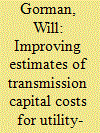|
|
|
Sort Order |
|
|
|
Items / Page
|
|
|
|
|
|
|
| Srl | Item |
| 1 |
ID:
169870


|
|
|
|
|
| Summary/Abstract |
Estimating the overall costs of transmission needed to integrate variable renewable energy (VRE) onto the grid is challenging. An improved understanding of these transmission costs would support electricity system planning as VRE penetrations increase. This paper brackets VRE transmission capital costs using multiple approaches based on interconnection studies, actual transmission projects, capacity-expansion simulation models, and aggregated U.S. VRE-related transmission expenditures. Each approach possesses advantages and drawbacks, and combining the approaches lends confidence to the results. The resulting range of average levelized VRE transmission costs is $1–$10/MWh, which is generally lower than earlier estimates in the literature. These transmission capital costs can increase the direct plant-level levelized cost of VRE by 3%–33%, based on levelized costs of energy of $29–$56/MWh for utility-scale wind and $36–$46/MWh for utility-scale solar. As VRE deployment continues to expand, policy makers can use this information to (1) assess the benefits of transmission avoidance and deferral when comparing distributed energy resources versus utility-scale projects, (2) evaluate the potential costs of large-scale public transmission investments, and (3) better analyze system-level costs of utility-scale VRE technologies. Future research can expand on the framework presented here by providing a review of operation and maintenance costs for transmission systems.
|
|
|
|
|
|
|
|
|
|
|
|
|
|
|
|
| 2 |
ID:
093533


|
|
|
|
|
| Publication |
2010.
|
| Summary/Abstract |
Improvement and expansion of the transmission grid is still an unresolved issue in the new competitive environment. In current electricity markets, transmission lines have become assets that need financial instruments for investors who wish to ensure steady long-term returns and to withstand short-term market volatility. The timing and the combination of new transmission investments is key to analyze their long-term effects. This paper presents the concept of net present value (NPV) curve to estimate the best investment time for the investor, where the curve is constructed by calculating the NPVs resulting from the investment in successive years. A specific contract model based on financial transmission rights (FTR) is used for the NPV evaluation of transmission assets, and the stochastic properties of all variables related to the investment market structure are considered. The model is applied to the IEEE 24-bus Reliability Test System (RTS) showing the approach capabilities as a decision-aid tool for transmission investors.
|
|
|
|
|
|
|
|
|
|
|
|
|
|
|
|
| 3 |
ID:
163529


|
|
|
|
|
| Summary/Abstract |
The need to decarbonize the power sector through increased participation of renewable generation has originated an escalating necessity for transmission network investments that can be undertaken by a number of market participants, including planning authorities/system operators, network companies and project developers. The expansion of the power network, however, presents various environmental and social conflicts, in particular, with land uses that are valuable by society such as the presence of communities, national parks, protected forests, tourism zones, archaeological sites, etc. In this context of environmental and social awareness, we assess the benefits of two strategies that coordinate network investments among various participants and compare them against the current counterfactual approach, where no coordination is undertaken and thus renewable generation projects are connected to the main transmission system in an individual, project-by-project basis. Through various case studies based on the main Chilean transmission system, we show that the lack of coordination in network investments may present severe impacts in terms of the socio-environmental externalities of transmission network expansions. Furthermore, we demonstrate that attempting to reduce externalities of new network investments without proper coordination of new developments may significantly limit the success of a land use policy associated with network developments.
|
|
|
|
|
|
|
|
|
|
|
|
|
|
|
|
|
|
|
|
|